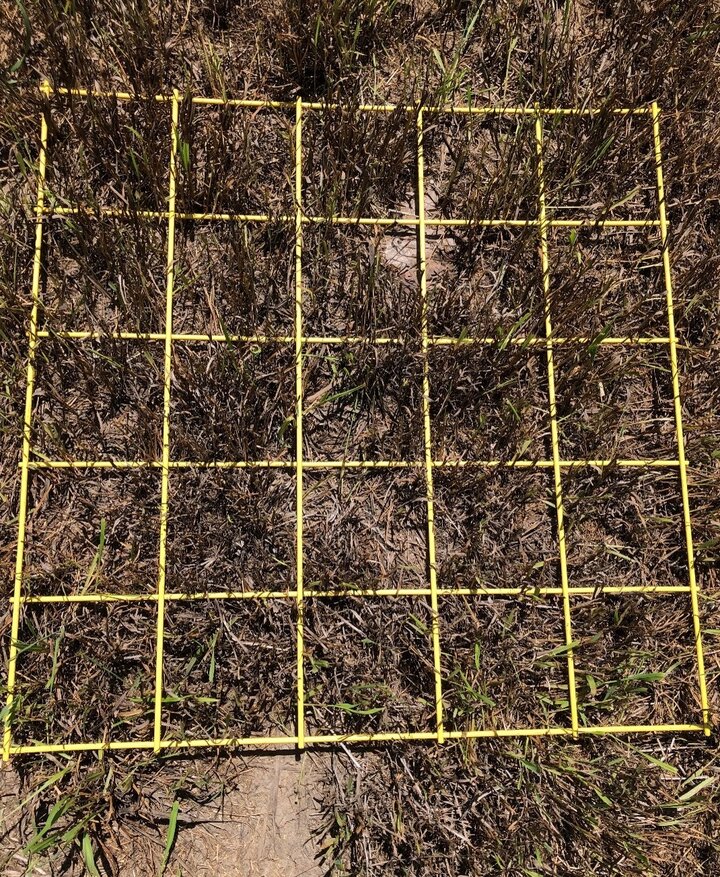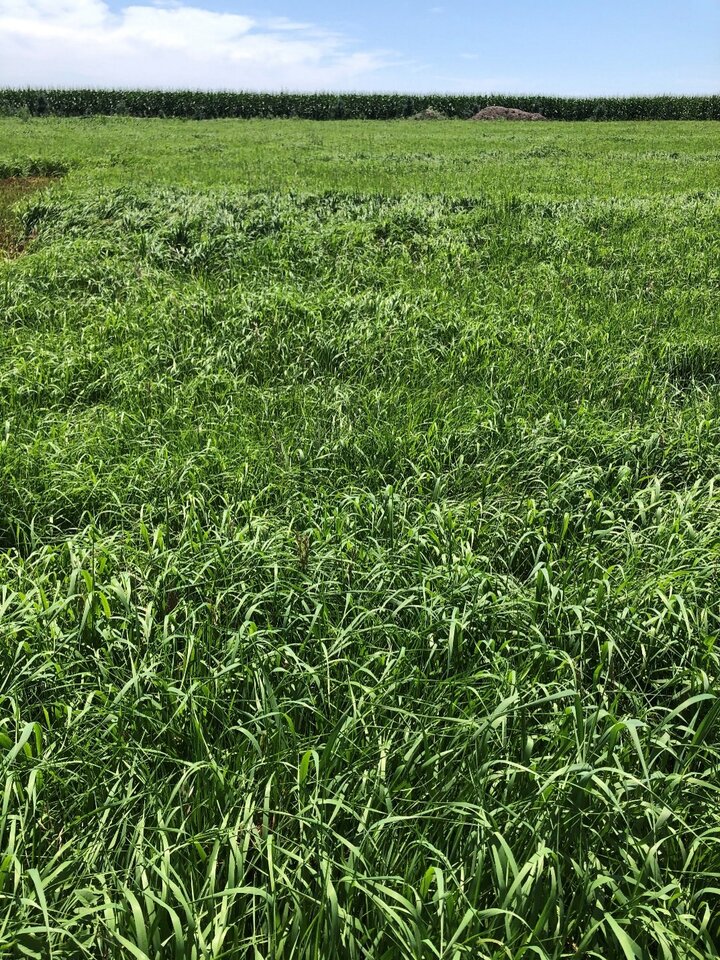Top 5 Takeaways
- A frequency grid can help determine the extent of stand damage and give you a baseline for evaluating pasture recovery.
- The extent of the damage will determine whether you will need to seed the pasture, or if a wait-and-see approach will be sufficient.
- For best recovery, it is vital to wait until after the first killing frost to graze drought-damaged smooth bromegrass pastures.
- Regardless of the extent of the damage, you will likely need to take an active, sooner-rather-than-later approach to weed management.
- Additional phosphorus can help strengthen smooth bromegrass root systems, even if the phosphorus levels are considered adequate.
Pasture Recovery Assessment
How well smooth bromegrass pastures recover after a drought depends on rainfall, management and how much damage occurred during the drought.
The best approach to post-drought smooth bromegrass pasture management is to reduce plant and animal competition and focus on moisture conservation and use. For additional information on managing grass recovery, please see “After Drought” on the National Drought Mitigation Center website.
Many smooth bromegrass pastures in eastern Nebraska are experiencing drought effects that date to September 2022. Recent precipitation in some of these areas has resulted in a few pastures beginning to green up and may have several inches of new growth. However, this seems more common for smooth bromegrass hay fields than grazed pastures. Hay fields do not have the continued, repeated forage removal that occurs with grazing. Currently, there are grazed pastures that look as if there is no hope of improvement this year. While this may be true in some instances, there are strategies that can be used to facilitate pasture recovery. To create a management strategy, start by assessing the drought damage and then create a pasture recovery plan.
Assessing Drought Damage
With a little time and material you probably have lying around, you can gather the data you need to accurately assess the drought damage and create a starting point for evaluating progress. This method uses a 5 x 5 grid from a section of cattle panel (30-inch x 30-inch frame with 25, 6-inch x 6-inch squares) (Fig. 1). A 9-minute video describing and demonstrating the use of the frequency grid can be found at https://www.youtube.com/watch?v=AXZN7-PmldU.
A summary of use is:
- Place the grid on a section of the pasture.
- Count each grid square that has at least one desirable plant (smooth bromegrass). Empty squares or squares with no desirable plants are not counted.
- Plants that cover more than one square are only counted once from where they were originally rooted.
- Repeat the process in 3 other areas of the pasture.
- Add the total number of squares counted with desirable plants from the four frames and divide by 100 to get % stand frequency.
For simplicity, drought-damaged pastures can be categorized into three classes:
- Fully functional (> 70% stand frequency) pastures can recover quickly with deferred grazing or harvest, weed control, and adequate fertility once satisfactory growing conditions return. Complete recovery may take only one to two months of uninterrupted growth.
- Damaged (40 to 70% stand frequency) pastures should also recover using a combination of deferred grazing or harvest, weed control, and proper fertility. Previous management practices, especially grazing and harvest management contributed to the pasture drought response and may need to be corrected to improve pasture recovery. Complete recovery of these pastures may require uninterrupted fall and early spring growth.
- Severely damaged (

- Figure 1. Frequency frame example showing 25/25 squares containing at least 1 green plant, along with drought-damaged growth from earlier in the spring.
Developing Pasture Recovery Strategies
Stand Conversion and Replacement
For pasture conversion, please see the guidelines in Nebraska Extension NebGuide G1705 (Establishing Dryland Forage Grasses). For stands that are severely damaged, stand replacement may be the only option. To improve pasture forage yield and animal production above historic levels, consider planting one of the newer, improved cool-season cultivars. Consider ‘Newell’ smooth bromegrass to replace older stands of ‘Lincoln’ smooth bromegrass and ‘Manska’ or ‘Beefmaker’ intermediate wheatgrass to replace stands of ‘Oahe’ or ‘Slate’ intermediate wheatgrass. You can increase species diversity by mixing in other suitable grass species, such as orchardgrass and meadow bromegrass or productive forage legumes like alfalfa or red clover.
Stand Enhancement
This strategy could include overseeding or interseeding without conversion and would be best suited for damaged and borderline severely damaged stands. Overseeding and interseeding will likely be challenging unless there are larger areas of absent plants. The greatest advantage to stand enhancement is the opportunity to increase species diversity by including productive forage legumes like alfalfa or red clover.
Wait-and-see (but don’t walk away)
The wait-and-see approach is only appropriate for those pastures that are borderline fully functional or damaged with stand frequencies close to 70%.
Post-drought Pasture Management
Grazing/Harvest Deferment
It is important to allow smooth bromegrass pastures to complete the fall growth cycle and not graze until after the first killing frost. This is especially critical for those pastures that are damaged with between 40 to 70% stand frequency. Fall growth translates to greater spring growth (more tillers) and will increase stand density and forage yield the following spring.
Weed Control
Almost certain is the need for weed control in both damaged and severely damaged smooth bromegrass stands. Pastures should be evaluated this fall for any fall-germinating broadleaf weeds that need to be controlled sooner rather than later. Proper identification of problem weeds will help to determine the best timing and method of control. From a forage management standpoint, it is better to spray a single time at an earlier date with a lower rate of herbicide than too late with an increased herbicide rate. In many cases, herbicides have minimal control on weeds once they reach a certain height, resulting in a costly herbicide application that fails to control the problem.
Fertility
Forage fertility should be given a priority, especially in severely damaged stands, especially if pastures have not been fertilized in the last few years. Many smooth bromegrass were grazed repeatedly during the drought, and root growth may be restricted in the top few inches of soil. It is important that these pastures have a strong root system to speed recovery. Soil phosphorus (P) Standard P fertility recommendations are based on stands with slight to moderate damage. Stands with severe damage may benefit from additional P, even with adequate available P levels. Nitrogen fertilizer should be applied only when soil moisture is present and smooth bromegrass is actively growing.
Note: Information in this article was synthesized from two extension publications Redfearn created in 2012 during his time at Oklahoma State University. This was specific to the assessment and recovery of warm-season pastures, which dominate Oklahoma forage-livestock systems. This article has been modified to focus on recovery of cool-season pastures, specifically smooth bromegrass.
Interviews with the authors of BeefWatch newsletter articles become available throughout the month of publication and are accessible at https://go.unl.edu/podcast. You can subscribe to the BeefWatch newsletter here: http://go.unl.edu/Beefwatch_subscribe
Topics covered:
Forages, Pasture & range, Grazing systems & best practices, Weather, Drought

